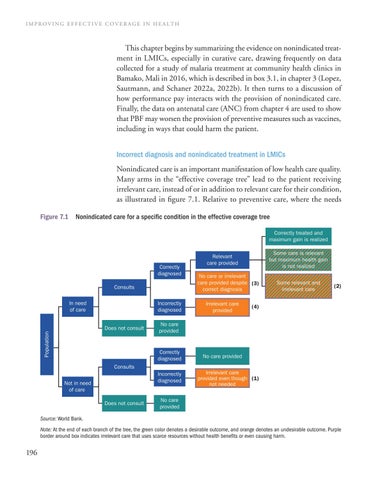IMPROVING EFFECTIVE COVERAGE IN HEALTH
This chapter begins by summarizing the evidence on nonindicated treatment in LMICs, especially in curative care, drawing frequently on data collected for a study of malaria treatment at community health clinics in Bamako, Mali in 2016, which is described in box 3.1, in chapter 3 (Lopez, Sautmann, and Schaner 2022a, 2022b). It then turns to a discussion of how performance pay interacts with the provision of nonindicated care. Finally, the data on antenatal care (ANC) from chapter 4 are used to show that PBF may worsen the provision of preventive measures such as vaccines, including in ways that could harm the patient. Incorrect diagnosis and nonindicated treatment in LMICs Nonindicated care is an important manifestation of low health care quality. Many arms in the “effective coverage tree” lead to the patient receiving irrelevant care, instead of or in addition to relevant care for their condition, as illustrated in figure 7.1. Relative to preventive care, where the needs Figure 7.1
Nonindicated care for a specific condition in the effective coverage tree Correctly treated and maximum gain is realized
Correctly diagnosed Consults In need of care
Incorrectly diagnosed
Population
Does not consult
Consults Incorrectly diagnosed
Does not consult
No care or irrelevant care provided despite (3) correct diagnosis Irrelevant care provided
Some relevant and irrelevant care
(2)
(4)
No care provided
Correctly diagnosed
Not in need of care
Some care is relevant but maximum health gain is not realized
Relevant care provided
No care provided Irrelevant care provided even though (1) not needed
No care provided
Source: World Bank. Note: At the end of each branch of the tree, the green color denotes a desirable outcome, and orange denotes an undesirable outcome. Purple border around box indicates irrelevant care that uses scarce resources without health benefits or even causing harm.
196

